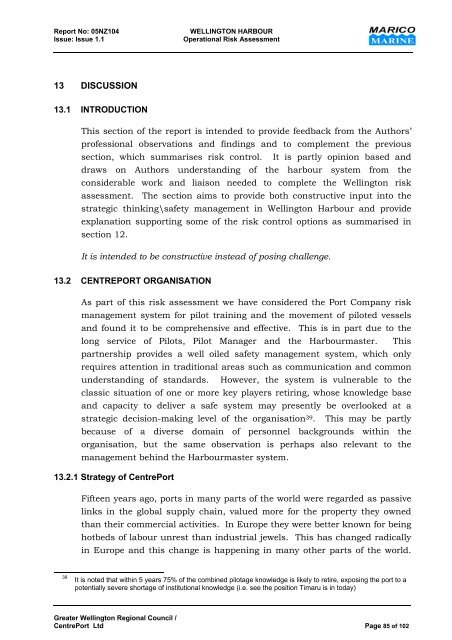MARICO Marine NZ Limited WELLINGTON HARBOUR PORT AND ...
MARICO Marine NZ Limited WELLINGTON HARBOUR PORT AND ...
MARICO Marine NZ Limited WELLINGTON HARBOUR PORT AND ...
Create successful ePaper yourself
Turn your PDF publications into a flip-book with our unique Google optimized e-Paper software.
Report No: 05<strong>NZ</strong>104 <strong>WELLINGTON</strong> <strong>HARBOUR</strong><br />
Issue: Issue 1.1 Operational Risk Assessment<br />
13 DISCUSSION<br />
13.1 INTRODUCTION<br />
This section of the report is intended to provide feedback from the Authors’<br />
professional observations and findings and to complement the previous<br />
section, which summarises risk control. It is partly opinion based and<br />
draws on Authors understanding of the harbour system from the<br />
considerable work and liaison needed to complete the Wellington risk<br />
assessment. The section aims to provide both constructive input into the<br />
strategic thinking\safety management in Wellington Harbour and provide<br />
explanation supporting some of the risk control options as summarised in<br />
section 12.<br />
It is intended to be constructive instead of posing challenge.<br />
13.2 CENTRE<strong>PORT</strong> ORGANISATION<br />
As part of this risk assessment we have considered the Port Company risk<br />
management system for pilot training and the movement of piloted vessels<br />
and found it to be comprehensive and effective. This is in part due to the<br />
long service of Pilots, Pilot Manager and the Harbourmaster. This<br />
partnership provides a well oiled safety management system, which only<br />
requires attention in traditional areas such as communication and common<br />
understanding of standards. However, the system is vulnerable to the<br />
classic situation of one or more key players retiring, whose knowledge base<br />
and capacity to deliver a safe system may presently be overlooked at a<br />
strategic decision-making level of the organisation39. This may be partly<br />
because of a diverse domain of personnel backgrounds within the<br />
organisation, but the same observation is perhaps also relevant to the<br />
management behind the Harbourmaster system.<br />
13.2.1 Strategy of CentrePort<br />
Fifteen years ago, ports in many parts of the world were regarded as passive<br />
links in the global supply chain, valued more for the property they owned<br />
than their commercial activities. In Europe they were better known for being<br />
hotbeds of labour unrest than industrial jewels. This has changed radically<br />
in Europe and this change is happening in many other parts of the world.<br />
39 It is noted that within 5 years 75% of the combined pilotage knowledge is likely to retire, exposing the port to a<br />
potentially severe shortage of institutional knowledge (i.e. see the position Timaru is in today)<br />
Greater Wellington Regional Council /<br />
CentrePort Ltd Page 85 of 102
















